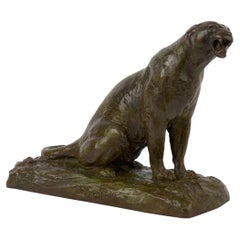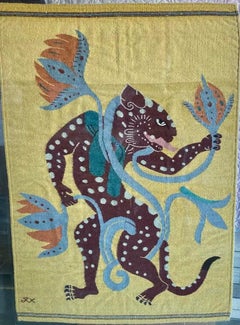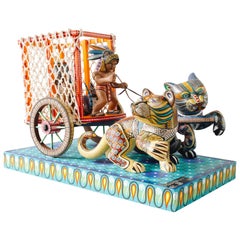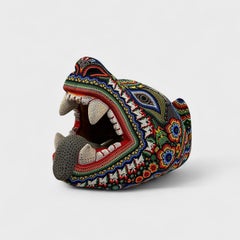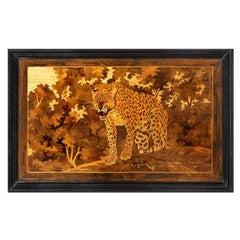Jaguar Art
Antique Late 19th Century French Modern Animal Sculptures
Bronze
21st Century and Contemporary More Art
Paint
2010s Realist Sculptures
Bronze
19th Century Other Art Style More Art
Wool
21st Century and Contemporary Surrealist Photography
C Print
21st Century and Contemporary Mexican Folk Art Toys
Acrylic, Wood
21st Century and Contemporary More Art
Wood
21st Century and Contemporary Photography
Silver Gelatin
Vintage 1920s French Art Deco Decorative Art
Ivory, Boxwood, Kingwood, Satinwood, Walnut
2010s Contemporary Animal Paintings
Oil, Canvas
21st Century and Contemporary Surrealist Still-life Photography
Photographic Paper
21st Century and Contemporary More Art
Glass, Wood
2010s Contemporary Figurative Sculptures
Stainless Steel
21st Century and Contemporary Contemporary Figurative Sculptures
Resin, Paint, Spray Paint, Acrylic
20th Century Figurative Paintings
Oil, Illustration Board
21st Century and Contemporary American Modern Animal Prints
Screen
2010s Contemporary Black and White Photography
Black and White, Archival Pigment
Late 20th Century Folk Art Sculptures
Wood, Paint
20th Century Modern Portrait Photography
Silver Gelatin
2010s Contemporary Color Photography
Giclée
21st Century and Contemporary Surrealist Figurative Prints
Gold Leaf, Silver
2010s Contemporary Animal Drawings and Watercolors
Sumi Ink, Rag Paper
2010s Contemporary Animal Drawings and Watercolors
Oil, Wood Panel
2010s Photorealist Paintings
Acrylic
Early 20th Century Art Deco Animal Prints
Etching
2010s Black and White Photography
Paper
2010s Photorealist Paintings
Acrylic
2010s Contemporary Black and White Photography
Archival Pigment
2010s Contemporary Color Photography
Archival Pigment
2010s Abstract Expressionist Abstract Paintings
Canvas, Paint, Acrylic
2010s Black and White Photography
Paper
2010s Pop Art Figurative Sculptures
Glass, Plastic, Mixed Media
21st Century and Contemporary Contemporary Figurative Sculptures
Bronze
21st Century and Contemporary Contemporary Figurative Sculptures
Cast Stone, Marble
2010s Realist Figurative Drawings and Watercolors
Acrylic, Paper
2010s Photorealist Figurative Paintings
Cotton Canvas, Acrylic
21st Century and Contemporary Contemporary Figurative Sculptures
Bronze
20th Century Other Art Style Figurative Sculptures
Precious Stone
1990s Contemporary Color Photography
Archival Paper, Photographic Paper, C Print, Color, Polaroid
2010s Contemporary Animal Paintings
Foil
1770s Modern Figurative Prints
Etching
2010s American Modern Color Photography
Cotton, Archival Ink, Photographic Paper
1850s Modern Figurative Prints
Lithograph
1850s Modern Figurative Prints
Lithograph
Mid-20th Century Mexican Folk Art Carnival Art
Wood
21st Century and Contemporary Contemporary Figurative Sculptures
Cast Stone
21st Century and Contemporary Contemporary Figurative Sculptures
Cast Stone
21st Century and Contemporary Surrealist Figurative Paintings
Canvas, Acrylic
21st Century and Contemporary Contemporary Figurative Prints
Digital, Ink
Pedro Friedeberg"Tiempos fáciles" contemporary, surrealist, geometric forms, jaguars, patterns, 2023
Late 18th Century Old Masters Figurative Prints
Etching
Mid-20th Century Impressionist Figurative Paintings
Oil, Canvas
21st Century and Contemporary Italian Decorative Art
Paper
1990s Contemporary Black and White Photography
Archival Paper, Photographic Paper, C Print, Color, Polaroid
1990s Contemporary Black and White Photography
Archival Paper, Photographic Paper, C Print, Color, Polaroid
2010s Colombian Figurines and Sculptures
Late 20th Century Contemporary Color Photography
Archival Pigment
2010s Contemporary Black and White Photography
Archival Pigment
2010s Contemporary Black and White Photography
Archival Pigment
- 1
